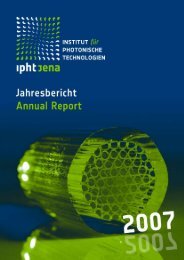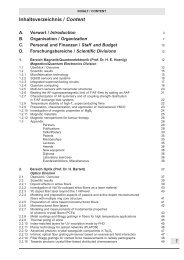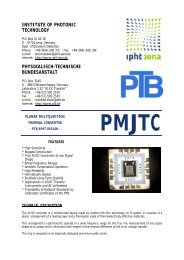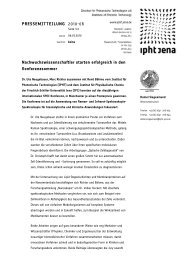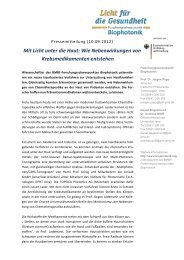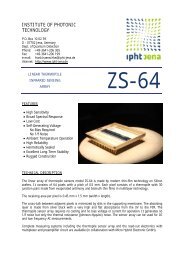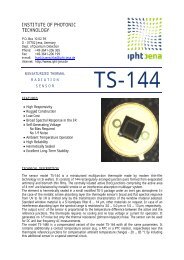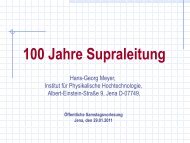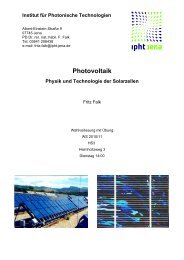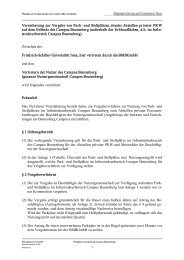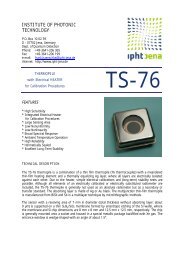Jahresbericht 2005 - IPHT Jena
Jahresbericht 2005 - IPHT Jena
Jahresbericht 2005 - IPHT Jena
Create successful ePaper yourself
Turn your PDF publications into a flip-book with our unique Google optimized e-Paper software.
46<br />
comprising a semiconductor laser and an extended<br />
external cavity. On the one hand, the FGL concept<br />
for Non-Return-to-Zero (NRZ) data transmission<br />
is considered as a potential low-cost data<br />
transmitter device; on the other hand, the laser<br />
output power and emission wavelength is shown<br />
to be sensitive to packaging, laser temperature<br />
and device current (see <strong>IPHT</strong> annual report<br />
2001).<br />
FGL understanding and optimization require simulation<br />
tools, which have been developed at the<br />
<strong>IPHT</strong>. The numerical method bases on the travelling<br />
wave model for DFB (distributed feedback)<br />
semiconductor lasers. As the lasing condition of<br />
the external cavity laser depends on its own history,<br />
the applied model splits the laser into individual<br />
sections, each with its own treatment of<br />
rate equations, (Bragg) reflections and losses.<br />
The simulation tools give access to the complex<br />
output power behaviour, mode jumps and eye.<br />
Additionally it is now possible to design special<br />
laser architectures like mode-hop-free FGLs with<br />
active wavelength stabilization and wavelengthswitchable<br />
FGLs, which are based on the interaction<br />
between the external cavity with superimposed<br />
Bragg gratings and the internal cavity,<br />
which comprises the semiconductor optical<br />
amplifier section.<br />
Fig. 2.15: Simulated eye diagrams of the virtual<br />
fibre-grating-laser at 2.5 Gbit/s. Shown are the<br />
eye diagrams with the emission wavelength at the<br />
Bragg wavelength (top) and at the long-wavelength<br />
slope close to a mode-hop (bottom).<br />
OPTIK / OPTICS<br />
2.2.10 Implementation of an OADM with a<br />
data rate of 10 Gbit/s as technology<br />
demonstrator in the PLATON project<br />
(Planar Technology for Optical Networks)<br />
(M. Rothhardt, C. Aichele, M. Becker,<br />
U. Hübner)<br />
The EU-funded PLATON Project involves collaboration<br />
and permanent feedback with a variety of<br />
European research partners: Université des Sciences<br />
et Technologies de Lille (France), Université<br />
Paris Sud (France), Ecole Polytechnique Fédérale<br />
de Lausanne (Switzerland), Technische Universität<br />
Hamburg Harburg (Germany), Instituto de<br />
Engenharia de Sistemas e Computadores do<br />
Porto (Portugal), and two industrial partners,<br />
Lucent Technologies GmbH (Nürnberg, Germany)<br />
and Highwave Optical Technologies (France).<br />
The objective of the PLATON project was to<br />
study, develop and assess photosensitive planar<br />
technology through key pilot devices. The main<br />
subject of interest is demonstrating the feasibility<br />
of the technology for making components like<br />
channel waveguides, multimode interferometers,<br />
Mach-Zehnder structures and Bragg gratings.<br />
The work aims at a reconfigurable optical adddrop<br />
multiplexer (OADM) which will be the final<br />
demonstrator.<br />
Objectives of the <strong>IPHT</strong> were particularly:<br />
(i) Accomplishing an optimized process for optical<br />
layer deposition<br />
(ii) Structuring the optical waveguides of the key<br />
pilot components (OADM)<br />
(iii) Realizing the Bragg gratings inside the optical<br />
waveguides<br />
(iv) UV trimming of the MZI structures (Mach<br />
Zehnder Interferometer) of the OADM’s<br />
(v) Packaging and fibre coupling of the optical<br />
chips.<br />
Fig. 2.16: OADM scheme with MZI structure, sections<br />
for UV trimming, input and output ports and<br />
Bragg grating regions.<br />
The main results are:<br />
(i) Optical layer deposition<br />
The well-mastered technology at the <strong>IPHT</strong> for<br />
optical silica layer deposition, FHD (Flame Hydrolysis<br />
Deposition) is applied for this project. The<br />
core layer is germanium-doped. Our parameters<br />
achieved are:<br />
Core layer thickness of 4.5 µm/5.2 µm and a<br />
refractive index of n[core] = 1.469. The refractive<br />
index tolerance is δn



